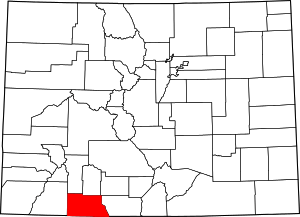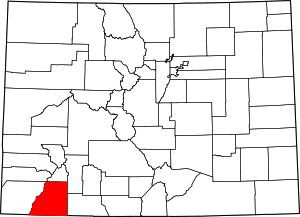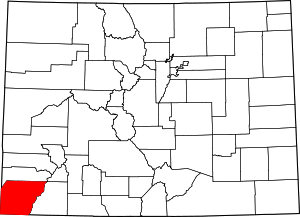Southern Ute Indian Reservation
The Southern Ute Indian Reservation is a Native American reservation in southwestern Colorado near the northern New Mexico state line. Its territory consists of land from three counties; in descending order of surface area they are La Plata, Archuleta, and Montezuma Counties. The reservation has a land area of 1,058.785 sq mi (2,742.24 km²). Its largest communities are Ignacio and Arboles.[3] The only other community that is recognized as a separate place by the Census Bureau is the CDP of Southern Ute, which lies just southeast of Ignacio.
Southern Ute Indian Reservation | |
|---|---|
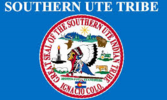 Flag | |
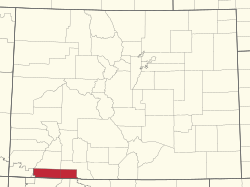 Location in Colorado | |
| Tribe | Southern Ute |
| Country | United States |
| State | Colorado |
| Counties | La Plata Archuleta Montezuma Counties |
| Headquarters | Ignacio |
| Government | |
| • Body | Tribal Council |
| • Chairman | Christine Sage |
| • Vice-Chairman | Cheryl Frost |
| • Treasurer | Lorelei Cloud |
| Population (2017)[2] | |
| • Total | 12,995 |
| Website | southernute-nsn.gov |
History
Historic bands
The Southern Ute tribes include the Muache, Capote, and the Weeminuche, the latter of which are at Ute Mountain. These tribes were considered the Southern Utes.
Capote
The Capote (Kapota, Kahpota) band lived east of the Great Divide south of the Conejos River and east of the Rio Grande towards the west site of the Sangre de Cristo Mountains, they were also living in the San Luis Valley, along the headwaters of the Rio Grande and along the Animas River, centered in the vicinity of today Chama and Tierra Amarilla of Rio Arriba County. Like the Mahgrahch the Kahpota maintained trade relations to Puebloan peoples and came into conflict with southern plains people because of their alliance with the Ollero band of the Jicarilla Apache.[4]
Muache
The Muache (Mouache, Mahgruhch, Mahgrahch, Muwac) band lived along the eastern foothills of the Rocky Mountains from Denver, Colorado in the north to Las Vegas, New Mexico in the south, traded with northern Puebloan peoples, especially with Taos Pueblo, therefore often called Taos-Ute, ranged after adoption of the horse with their allies, the Llanero band of the Jicarilla Apache, southeastward as far as the Texas Panhandle.
Treaties with the U.S. government
Ouray of the Uncompahgre band was appointed by President Abraham Lincoln as head of all Ute tribes, which was not agreed upon by the Southern Ute bands. The first reservation created by the treaty of 1868 encompassed about 1/3 of present-day Colorado, mostly the mountainous regions west of the continental divide. When precious metals and minerals were discovered in the central mountains settlers sought access to the land. In 1873 The Brunot Agreement was created. This agreement limited the reservation to the narrow strip of land that is called The Southern Ute Reservation today. The United States also made treaties with various bands of Ute in 1855, 1865, and 1866, which the Senate failed to ratify. Initially given the whole of eastern Colorado for a reservation, the discovery of gold there in the 1860s brought a quick reduction in territory. The treaty with the Ute in 1865 provided for the cession of land in exchange for the entire valley of the Uintah River in Utah, plus $25,000 per year for ten years, then $20,000 for 20 years, and thereafter $15,000 per year, based on an estimated population of 5,000 Ute. The treaty also banned liquor and provided for the establishment and maintenance of a manual labor school for ten years.[5]
Reservation
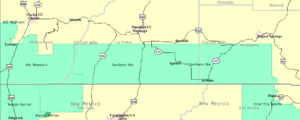

The Southern Ute Indian Reservation was opened in southwestern Colorado. The eastern part of the reservation is forest with elevations of more than 9000 feet. The western portion is mostly arid mesa. The actual land lies in the southwestern corner of the state of Colorado and consists of a strip 15 miles north to south and 110 miles east to west. In 1895 The Hunter Act distributed the land in the reservation in plots to the heads of households in the Mouache and Capote tribes. The Weeminuche tribe had approved an 1888 congressional bill relocating them to San Juan County, Utah, however this bill did not pass so the Weeminuche were brought back to Colorado. They refused to go back to the old grounds of the agency so they established camps on the western end of the Southern Ute Reservation. With the three tribes given their land the final provisions of the Hunter Act were implemented opening over 500,000 acres of the Reservation to non-native settlers.
Established in 1873, it is the reservation of the Southern Ute Indian Tribe, a federally recognized Ute tribe. The southern Utes are made up of two bands, the Mouache and the Capote. Government is organized under the Indian Reorganization Act of 1934 and is led by a tribal council with a chairman as head of the executive. For decades at the end of the 20th century, Leonard C. Burch had been the tribes chairman. In 2008 a new chairman, Matthew Box was elected.[6]
Census
Census population in Southern Ute Reservation in 1980 and 20 years later, 2000.
Southern Ute Reservation 1980 2000
Archuleta County 2,257 4,796
La Plata County 259 695
Montezuma County 1,998 4,101
Tribal chairman
Matthew Box resigned as Tribal Chairman in 2011. Under a special election Pearl Casias was elected as the first Chairwoman in the history of the Tribe and served for a time in 2011.[7] Jimmy Newton served as Tribal Chairman from 2012 until his death in 2014.[8] Clement Frost served as Tribal Chairman following Newton's death in 2014.[9] Frost retired in 2017, and in December 2017 Christine Baker-Sage was elected to serve as Tribal Chairwoman.[10]
Economy
The Southern Ute Indian Tribe’s coalbed methane capture project has reduced greenhouse gas emissions by the equivalent of about 379,000 metric tons of carbon dioxide between 2009 and 2017.[11] Conventional coalbed methane production wells were not economically feasible in this location due to the low volume of seepage.[12] The project delivers its gas to natural gas pipelines, and generates additional revenue through the sale of carbon offsets.[11][13]
Notable people
- Joseph Rael, (b. 1935), dancer, author, and spiritualist
Notes
- "Southern Ute Tribal Council". Retrieved 2019-07-24.
- 2013-2017 American Community Survey 5-Year Estimates. "My Tribal Area". United States Census Bureau.
- Southern Ute Reservation, Colorado Archived 2020-02-11 at Archive.today United States Census Bureau.
- "Chapter Five - The Northern Utes of Utah". utah.gov.
- Treaty Making: Southern Plains and the Southwest." In The American Mosaic: The American Indian . : , 2014. .
- "New Ute tribal chairman Matthew Box sworn in " News From Indian Country December 2008
- Southern Ute Indian Tribe.Chairmen. Retrieved: 2017-05-05.
- Indian Country Today. Southern Utes Mourn Loss of Tribal Chairman Jimmy Newton Jr., April 3, 2014. Retrieved: 2017-05-05.
- Mazur, Melanie Brubaker (2014-12-15). "Clement Frost returns as tribal chairman". The Durango Herald. Retrieved 2017-05-05.
- Rupani, Mia (2017-12-16). "Southern Utes usher in new leadership". The Durango Herald. Retrieved 2017-12-18.
- Mullane, Shannon (July 9, 2019). "Outdoors industry taps into Southern Ute methane capture project". Durango Herald. Retrieved 2019-12-21.
- "Southern Ute Indian Tribe: Natural Methane Capture and Use". Native Energy. 2018. Retrieved 2019-12-21.
- "Colorado - Native American Methane Capture". Cool Effect. Retrieved 2019-12-21.
References
- Pritzker, Barry M. A Native American Encyclopedia: History, Culture, and Peoples. Oxford: Oxford University Press, 2000. ISBN 978-0-19-513877-1.
External links
- The Southern Ute Indian Tribe, official website
